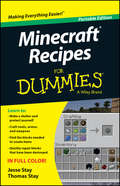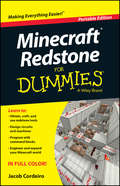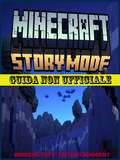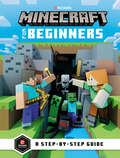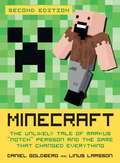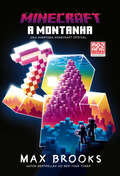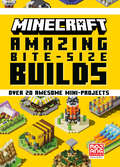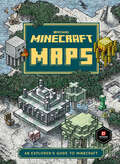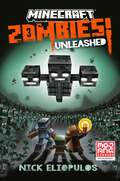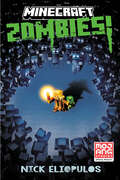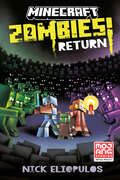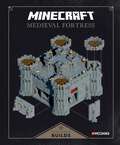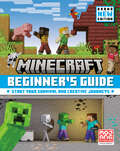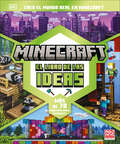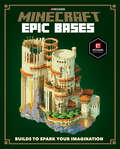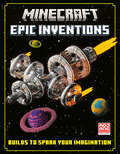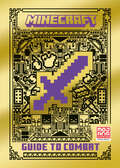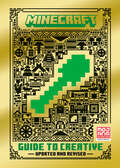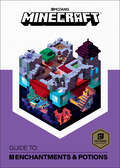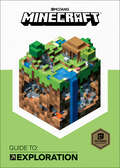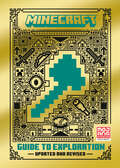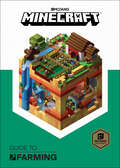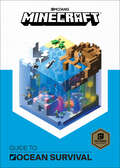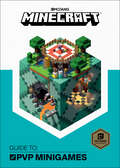- Table View
- List View
Minecraft Recipes For Dummies
by Jesse Stay Thomas StayA quick, handy reference on Minecraft recipesWant to find resources, make a shelter, craft tools, armor, and weapons, and protect yourself from monsters with Minecraft recipes? You've come to the right place! In a handy, portable edition that's packed with step-by-step instructions, Minecraft Recipes For Dummies makes it easy to look up the required items and figure out which blocks you need to gather to create each item. You'll get recipes for weapons, armor, transportation, mechanism, food, dye, wool, and brewing, as well as information on enchanting, repairing, gathering, farming, efficiency, and more.Minecraft is more than just a game: it's an obsession. It has gone from an obscure game with a cult-like following to a mainstream phenomenon. Minecraft consists of players using an avatar to create or destroy various types of blocks, form fantastic structures, create artwork, and much more, all in a three-dimensional environment and across various multiplayer servers in multiple game modes. With this fun and friendly guide, you'll get quick and easy access to Minecraft recipes to enhance your game and get even more out of this popular, addictive game.Shows you which blocks you'll need to gather to create shelter, tools, armor, weapons, and moreMakes it easier for both beginner and advanced Minecraft players to make the most of the gamePlaying the game teaches users basic programming skills and engineering conceptsThe author's sons--both avid Minecraft players and bloggers--contributed to the writing of this bookMinecraft Recipes For Dummies is the portable guide that goes where you go as you create a world you'll never want to leave.
Minecraft Redstone For Dummies
by CordeiroThe indispensable primer for achieving redstone greatnessMinecraft Redstone For Dummies is the complete guide to finding, using, and maximizing the power of redstone in the Minecraft world. This key element is essential for crafting and brewing, and can be placed on the ground as redstone dust - a flat, transparent block that can transmit redstone power, the major component of most redstone circuits. Written by a recognized Minecraft expert, this useful guide walks you through mining, smelting, and other methods of obtaining redstone, and teaches you how to make the most of your redstone stores. Craft a compass, piston, lamp, or torch, brew a potion that reverts to Level 1, or turn it to dust to help find nearby power components. Whether you're in Creative or Survival mode, redstone mastery is crucial for successful gameplay.Minecraft is a worldwide phenomenon, boasting over 100 million players from around the world. While gameplay varies according to player preference, redstone remains a central element that allows players to build, brew and create as they advance through the biomes. Minecraft Redstone For Dummies teaches you everything you need to know about redstone, including how to get it and how best to use it.Learn which methods result in more redstone per attemptDiscover how redstone is used in crafting and brewingUse redstone dust to build circuits and power mechanical componentsUnderstand redstone power, including source, levels, and configurationDon't be content to acquire what you stumble across. Redstone's versatility makes it an indispensable resource in the Minecraft world, and knowing where to find it and how to use it efficiently can make all the difference in your gameplay. If you're ready to level up, Minecraft Redstone For Dummies will make you a redstone guru in no time.
Minecraft Story Mode: Guida non ufficiale
by Joshua Abbott A. S.*GUIDA NON UFFICIALE* Guida strategica avanzata e consigli. Questa è la guida più esaustiva e dettagliata che potete trovare su Internet. Disponibile immediatamente sul vostro cellulare, lettore ebook o in formato cartaceo. Dopo il successo delle mie centinaia di altre guide strategiche, ho scritto un'altra guida professionale per i giocatori nuovi e quelli più avanzati. Questa guida offre strategie specifiche e consigli su come andare avanti nel gioco, battere gli avversari, ottenere più monete e molto altro! - Strategie e consigli professionali. - Trucchi - Segreti, consigli, trucchi utilizzati da giocatori professionisti! - Come ottenere molte monete/valuta. - E MOLTO ALTRO! Tutte le versioni di questa guida sono corredate di screenshot per aiutarvi a comprendere meglio il gioco. Non esistono guide più esaustive e avanzate di questa. Attenzione: Questo prodotto non è in alcun modo affiliato, associato, promosso o pubblicizzato dal detentore originale dei diritti d'autore.
Minecraft for Beginners (Minecraft)
by Mojang AB The Official Minecraft TeamCurious about Minecraft, but not sure where to start? This book is just what you need. With its open-ended game play, massive world and dedicated fan base, Minecraft is a richly rewarding experience—once you get the hang of it. With easy-to-follow instructions, tips and tricks from the experts behind the game, Minecraft for Beginners will help you survive and thrive. You&’ll learn how to find food, build a shelter, mine for materials and craft armor, swords and other equipment, plus get the inside scoop on places to go and the monsters you&’ll encounter. What are you waiting for? Begin your Minecraft adventure today! This ebook is best viewed on a color device with a larger screen.Collect all of the official Minecraft books:Minecraft: The IslandMinecraft: The CrashMinecraft: The Lost JournalsMinecraft: The Survivors&’ Book of SecretsMinecraft: Exploded Builds: Medieval FortressMinecraft: Guide to ExplorationMinecraft: Guide to CreativeMinecraft: Guide to the Nether & the EndMinecraft: Guide to RedstoneMinecraft: MobestiaryMinecraft: Guide to Enchantments & PotionsMinecraft: Guide to PVP MinigamesMinecraft: Guide to FarmingMinecraft: Let&’s Build! Theme Park AdventureMinecraft for Beginners
Minecraft, Second Edition
by Daniel Goldberg Linus LarssonThe incredible tale of a little game that shook the international gaming world--now with new material including a behind-the-scenes look at the sale to Microsoft.For this second edition, the story has been enriched with more Minecraft than ever--a new section describes Minecraft's sale to Microsoft, Notch's less than heartwarming last day in the office, and Mojang's final days of independence. His whole life, all Markus Persson wanted to do was create his own games. Create his own games and get rich. Then in 2009 a strange little project of his quickly grew into a worldwide phenomenon and, in just a few short years, turned its maker into an international icon.Minecraft: The Unlikely Tale of Markus "Notch" Persson and the Game that Changed Everything is a Cinderella story for the Internet age--improbable success, fast money, and the power of digital technology to shake up a rock-solid industry. It's a story about being lost and finding your way, of breaking the rules and swimming against the current. It's about how the indie gaming scene rattled the foundations of corporate empires. But, above all, this is the story of how a creative genius chased down a crazy dream: the evolution of a shy amateur programmer into a video game god.
Minecraft: A Montanha
by Max BrooksUMA AVENTURA IMPERDÍVEL DO UNIVERSO MINECRAFT! Ele não sabe o seu nome, nem onde está, nem como sobreviver, nem como voltar para casa. E no mundo de Nether, com uma ajuda preciosa, luta pela vida contra mobs e zombies. Uma lição sobre amizade e sobrevivência.
Minecraft: Amazing Bite-Size Builds (Minecraft)
by Mojang AB The Official Minecraft TeamLearn how to design, build and customize 20 mini-projects in Minecraft, from firefighter planes and deep-sea submarines to hidden bunkers and arcade games. There&’s even a superhero flying school! With detailed instructions, block hacks and build tips, this book will teach you new tricks and help you practice old skills as you create bite-size builds to impress your friends in Minecraft.
Minecraft: An Explorer's Guide to Minecraft (Minecraft)
by Mojang AB The Official Minecraft TeamDiscover the hidden corners of the many weird and wonderful locations in Minecraft with this beautifully illustrated, full-color guide--written in official partnership with the experts at game-creator Mojang.Are you ready for an adventure? Minecraft: Maps is a visual guide to the Minecraft landscape, created by an explorer on a quest to find the most valuable loot while avoiding danger. Explore each of the fifteen major biomes through highly detailed, illustrated maps, then read the explorer's notes about the unique features and discover an inspirational themed build idea for each.A beautifully illustrated visual guide in its own right, Minecraft: Maps is also a survival tool. You'll learn which biomes are home to the most dangerous mobs, where to look for exclusive blocks, how to find naturally generated structures and the best places to search for loot. Once you've discovered each biome you can get building--construct an ice palace in the ice plains biome and an entire village suspended in the tree canopy above the jungle floor.Biomes: Badlands, Dark Forest, Desert, Forest, Jungle, Mountains, Mushroom Fields, Ocean, Plains, Savanna, Snowy Tundra, Swamp, Taiga, The Nether, The End
Minecraft: An Official Minecraft Novel (Minecraft)
by Nick EliopulosThe Overworld is in trouble. On the ground, a rampaging army of armor-clad zombies is roving across the biomes. In the sky, a wicked Wither is leaving a path of destruction—and Wither roses—wherever it goes. And in Bobbie&’s party, the tension is tighter than a skeleton&’s bowstring . . . because, somehow, Logan just became its newest member. The same Logan who set zombies on Bobbie&’s village and turned her little brother, Johnny, into one of the walking dead. Who bullied her friend Ben and wrecked his adventuring career. Who was mean to his minion, Other Ben (who prefers Benjamin, actually). But as the Wither skulls start flying, this not-so-merry band needs all the help it can get. Bobbie hasn&’t forgotten her main mission: Find the zombified villagers who were once her friends and family and feed them the enchanted golden apples that will turn them back. But as long as the Wither exists, there&’s danger. And if there&’s danger, it&’s a hero&’s job to fix it. As much as Bobbie dislikes heroes, she and her friends (and also Logan) look like the closest thing the Overworld&’s got.
Minecraft: An Official Minecraft Novel (Minecraft)
by Nick EliopulosMeet the next big thing in the world of official Minecraft novels: zombies!Looking after a little sibling can be a real headache . . . especially when they&’re a zombie trying to eat your brains! Life is good for Bobbie in the sleepy village of Plaintown. Sure, her villager parents only ever say &“Hrm,&” but you pick up the local language quickly. And maybe her little brother, Johnny, is always getting into trouble, but the village&’s iron golem is there to look out for him. And, yeah, things are too busy for exploring when you&’re the only one in town who ever takes their hands out of their sleeves. But maybe that&’s for the best. After all, there are things out there beyond the torchlight that are better handled by adventurers. But one night, a stranger comes to Plaintown—and he&’s followed by a horde of ravenous zombies! Bobbie&’s village is overrun, and her world is turned upside down as her friends, family, and neighbors fall victim to the zombies&’ endless appetite. Life is not so good for Ben, an adventurer with nothing left to his name but the armor on his back. When dawn&’s light shows him an abandoned village, he sees it as a chance to pick through the wreckage and get himself back on track. What he wasn&’t expecting to run into was a desperate girl with a baby zombie villager on a leash. Bobbie and Johnny are the only ones left . . . and her brother&’s a lot greener and a lot bitier than he was last night. There&’s still some of Johnny rattling around the little zombie monster&’s mind; Bobbie just knows it. And Ben might know a way to bring him back.As the two journey across the Overworld, dragging Johnny along (literally), they brave dangerous depths, terrifying mobs, and an expanding mystery. Was the zombie attack on Bobbie&’s village really just bad luck? Where did the rest of the zombies go? And how exactly do you take care of a little brother who can&’t stop trying to eat you? Hold onto your brains—and your bows—and get ready to enter Minecraft: Zombies!
Minecraft: An Official Minecraft Novel (Minecraft)
by Nick EliopulosJust when you thought it was safe to go back into the Overworld, the zombies have returned!Bobbie is on a mission. She&’s already survived one encounter with Logan, the zombie-herding jerk who attacked her village and turned her brother into a zombie. And now she won&’t rest until she stops his evil plan to conquer the Overworld with his zombie horde. But the closer she gets to foiling Logan, the further away she gets from her original goal: finding a cure for her zombie brother.Ben is on . . . babysitting duty. Separated from Bobbie, Ben is now in charge of caring for her zombie-fied little brother, Johnny, and keeping up with his Zombie Obedience Lessons. Lessons that are going well! Johnny doesn&’t even need his leash anymore, and he hardly tries to eat people at all—unless they really, really deserve it. Logan&’s abandoned lair is even starting to feel a little like home.But while doing a little spring cleaning, Ben discovers Logan&’s secret diary, filled with all his biggest plots, including his next target: a legendary hero named Pigstep Peggy. Now, it&’s a race against time. Can Ben track down Bobbie and stop Logan before his zombies feast again? Can they win Peggy over to their cause? Will Johnny ever stop hungering for brains? Find out all this and more . . . as soon as you stop reading this summary and start reading Minecraft: Zombies Return!
Minecraft: An Official Mojang Book (Minecraft)
by Mojang AB The Official Minecraft TeamHave you ever wanted to create your own legendary medieval kingdom to rule over? Well, now you can, with Minecraft Exploded Builds: Medieval Fortress. Learn how to design, build, and customize every part of your castle and the surrounding area, from sturdy walls and deadly traps to dank, dark dungeons and sprawling villages. Each build has an exploded view to show you exactly which blocks to use, plus extra ideas to make every part of your kingdom unique. Packed with interesting facts about medieval life, full-color illustrations, and a foldout depicting the epic scale of the kingdom, this official Mojang book has dozens of building ideas to ignite the imaginations of Minecrafters of all ages.This ebook is best viewed on a color device with a larger screen.Collect all of the official Minecraft books:Minecraft: The IslandMinecraft: The CrashMinecraft: The Lost JournalsMinecraft: The Survivors&’ Book of SecretsMinecraft: Exploded Builds: Medieval FortressMinecraft: Guide to ExplorationMinecraft: Guide to CreativeMinecraft: Guide to the Nether & the EndMinecraft: Guide to RedstoneMinecraft: MobestiaryMinecraft: Guide to Enchantments & PotionsMinecraft: Guide to PVP MinigamesMinecraft: Guide to FarmingMinecraft: Let&’s Build! Theme Park AdventureMinecraft for Beginners
Minecraft: Beginner's Guide (Minecraft)
by Mojang AB The Official Minecraft TeamDive into Minecraft headfirst with this all-new beginner&’s guide that will teach you everything you need to know for starting your Minecraft journey, whether that be in Survival mode or Creative. Are you new to Minecraft or still not quite getting the hang of it? Then this book is for you! Join characters such as Miss Hap, Sir Vival and Bill Ding on an adventure through the Overworld, to discover how you can ace your early game.Learn everything from what happens when you die and how to avoid it to how to feed yourself and where to find the cutest mobs. So what are you waiting for? Pick up the book and start your epic adventure!Full of fun and humor, this guide is perfect for kids of all ages.
Minecraft: El libro de las ideas (The Minecraft Ideas Book)
by DKEste libro oficial de Minecraft te trae más de 70 increíbles ideas de construcción, además de los mejores trucos y consejos de constructores expertos.Despierta tu imaginación con ideas inspiradas en el mundo que nos rodea. Descubre datos curiosos y aprende a construir paisajes, maravillas naturales, inventos ¡y mucho más! Desde la Gran Muralla China y la Gran Barrera de coral hasta los trenes de vapor o la Estación Espacial Internacional.Sumérgete en las páginas de este libro de Minecraft y descubre:Cuatro capítulos con diferentes temáticas de construcción: historia, geología, viajes, vehículos…Una lista de datos del mundo real sobre cada modelo para que los niños aprendan a la vez que construyenImágenes ampliadas que muestran con gran detalle cómo se ha construido cada parteSecciones transversales que muestran el interior de los modelos.El libro de las ideas de Minecraft está repleto de ideas: un parque de atracciones, la casa de tus sueños, el campamento base del Monte Everest, una selva tropical con tirolesa y mucho más. ¡Observa el mundo real y el de Minecraft como nunca antes lo habías hecho! -------------------------------------------Discover more than 70 mind-blowing build ideas – plus tips, tricks, and hacks from expert Minecraft builders in this official Minecraft book.Spark your imagination with incredible build ideas inspired by the world around us. Explore landmarks, natural wonders, and inventions. From the Great Wall of China and the Great Barrier Reef, to steam trains and the International Space Station, learn how to build them all in Minecraft – and discover fascinating facts about them, too. The Minecraft Ideas Book is packed with all kinds of imaginative build ideas, including a cross-section of a volcano, ideas for designing your dream house, a fabulously fun theme park, a Mount Everest base camp, a rainforest with zip-wire, and much, much more. Why not step back in time to build the Titanic or a Roman chariot race or fast-forward to the future and build a sustainable city? Anything is possible! What will you build first? Find building techniques, hints, and tips throughout, such as block hacks, planning tips, and ideas for customizing. Meet the expert builders and discover where they get their ideas from. See the Minecraft world – and the real world – as you’ve never seen it before! © 2023 Mojang AB.
Minecraft: Epic Bases (Minecraft)
by Mojang ABDiscover new and exciting Minecraft base builds, with construction tips, blueprint spreads, and fun locations—written in official partnership with the experts at game-creator Mojang.Are you an expert builder? Looking for inspiration for your next epic build? Then the search is over!Visit the legendary bases of The Twelve, a guild of expert builders, who are ready to showcase their most stunning creations, including flying airships and underwater lairs. Learn their top tips and tricks for making incredible bases in a variety of themes, and follow their expert advice to create challenging structures and complex redstone mechanisms.Full of thematic builds and unique features, this book of exceptional bases will spark the imagination of Minecrafters young and old.
Minecraft: Epic Inventions (Minecraft)
by Mojang AB The Official Minecraft TeamTwelve mind-blowing Minecraft builds to spark your imagination.Epic Inventions contains twelve incredible builds to inspire you to construct the most inventive builds in Minecraft. There's an intergalactic space station, an ancient temple, a kawaii waterways course, a giant meeple bedroom, an animal sanctuary, plus many more. Each build is presented to you by its builder—a construction expert eager to share their tips with you. As well as learning how to choose blocks and construct amazing builds, you'll also learn some excellent pro builder tips like how to terraform the landscape.
Minecraft: Guide to Combat (Minecraft)
by Mojang AB The Official Minecraft TeamLearn how to survive and thrive in Minecraft with this brand-new guide! With insider info and tips from the experts at game-creator Mojang on how to defeat mobs and defend your base, this is a must-have, fully illustrated guide to combat. Don your armor, pick up your sword and charge headfirst into Minecraft: Guide to Combat—the only book you need to take your game to the next level. Read how to craft the deadliest weapons and enchant them with mystical powers, discover the vicious mobs that you&’ll go toe-to-toe with, and learn crafty strategies that will help you best your friends in PVP. With so much to explore, there&’s sure to be something for &’crafters of every level.
Minecraft: Guide to Creative (Minecraft)
by Mojang AB The Official Minecraft TeamThe official Minecraft: Guide to Creative will teach you all you need to know to create builds more impressive than you could&’ve dreamed of.The world of Minecraft is so varied and limitless that incredible creations can often be daunting to think about, never mind to build. With insider info and tips from the experts at Mojang, this is the definitive guide to creation in Minecraft.This ebook is best viewed on a color device with a larger screen.Collect all of the official Minecraft books:Minecraft: The IslandMinecraft: The CrashMinecraft: The Lost JournalsMinecraft: The Survivors&’ Book of SecretsMinecraft: Exploded Builds: Medieval FortressMinecraft: Guide to ExplorationMinecraft: Guide to CreativeMinecraft: Guide to the Nether & the EndMinecraft: Guide to RedstoneMinecraft: MobestiaryMinecraft: Guide to Enchantments & PotionsMinecraft: Guide to PVP MinigamesMinecraft: Guide to FarmingMinecraft: Let&’s Build! Theme Park AdventureMinecraft for Beginners
Minecraft: Guide to Creative (Minecraft)
by Mojang AB The Official Minecraft TeamThis classic Minecraft game guide is now completely revamped with 100% new information for the latest version of the game! Discover all the insider tips and tricks in this definitive, fully illustrated guide to creative mode in Minecraft.Minecraft is a sandbox game where anything is possible! With over 600 blocks to choose from, getting started can feel overwhelming. This updated guide will give you all the tools you need to become an expert builder. Whether it&’s choosing your blocks or decorating your build, this book is packed with expert advice, top tips and advanced tricks to take your construction skills to the next level. Read how to plan builds, create color palettes, use effective lighting and much more. This book also features advice from pro build teams and YouTubers, and includes step-by-step builds to complete in-game. With so much to explore, there&’s sure to be something for &’crafters of every level.
Minecraft: Guide to Enchantments & Potions (Minecraft)
by Mojang AB The Official Minecraft TeamThe official Minecraft: Guide to Enchantments & Potions will teach you how to enchant your equipment with useful effects and brew all manner of potions to protect yourself from harm. The world of Minecraft is perilous: Danger lurks around every corner, and you&’ll need powerful tools and equipment if you want to survive. With insider info and tips from the experts at Mojang, this is the definitive guide to Minecraft sorcery.This ebook is best viewed on a color device with a larger screen.Collect all of the official Minecraft books:Minecraft: The IslandMinecraft: The CrashMinecraft: The Lost JournalsMinecraft: The Survivors&’ Book of SecretsMinecraft: Exploded Builds: Medieval FortressMinecraft: Guide to ExplorationMinecraft: Guide to CreativeMinecraft: Guide to the Nether & the EndMinecraft: Guide to RedstoneMinecraft: MobestiaryMinecraft: Guide to Enchantments & PotionsMinecraft: Guide to PVP MinigamesMinecraft: Guide to FarmingMinecraft: Let&’s Build! Theme Park AdventureMinecraft for Beginners
Minecraft: Guide to Exploration (Minecraft)
by Mojang AB The Official Minecraft TeamThe official Minecraft: Guide to Exploration will help you survive. Learn how to find resources, craft equipment and protect yourself from hostile mobs.The world of Minecraft is waiting to be explored. But danger lurks around every corner and survival can prove difficult for even the bravest adventurer. With insider info and tips from the experts at Mojang, this is the definitive guide to exploration for new Minecrafters.This ebook is best viewed on a color device with a larger screen.Collect all of the official Minecraft books:Minecraft: The IslandMinecraft: The CrashMinecraft: The Lost JournalsMinecraft: The Survivors&’ Book of SecretsMinecraft: Exploded Builds: Medieval FortressMinecraft: Guide to ExplorationMinecraft: Guide to CreativeMinecraft: Guide to the Nether & the EndMinecraft: Guide to RedstoneMinecraft: MobestiaryMinecraft: Guide to Enchantments & PotionsMinecraft: Guide to PVP MinigamesMinecraft: Guide to FarmingMinecraft: Let&’s Build! Theme Park AdventureMinecraft for Beginners
Minecraft: Guide to Exploration (Minecraft)
by Mojang AB The Official Minecraft TeamDiscover everything you need to become an Overworld explorer with this brand-new Guide to Minecraft!Minecraft is a sandbox game where anything is possible! The Overworld is yours to explore—but knowing where to adventure and how to survive the dangers is a test for even the most experienced player.From navigating biomes and surviving in the wild, to finding hidden structures and the rare treasures they hold—this official handbook will guide you through becoming the ultimate explorer.
Minecraft: Guide to Farming (Minecraft)
by Mojang AB The Official Minecraft TeamThe official Minecraft: Guide to Farming will teach you about everything form basic crop farming and animal breeding to hostile mob and block farming. In Survival mode you&’re constantly in need of food and other useful items, and true survivors knows the importance of setting up their own farming systems. With insider info and tips from the experts at Mojang, this is the definitive guide to becoming self-sufficient in Minecraft.This ebook is best viewed on a color device with a larger screen.Collect all of the official Minecraft books:Minecraft: The IslandMinecraft: The CrashMinecraft: The Lost JournalsMinecraft: The Survivors&’ Book of SecretsMinecraft: Exploded Builds: Medieval FortressMinecraft: Guide to ExplorationMinecraft: Guide to CreativeMinecraft: Guide to the Nether & the EndMinecraft: Guide to RedstoneMinecraft: MobestiaryMinecraft: Guide to Enchantments & PotionsMinecraft: Guide to PVP MinigamesMinecraft: Guide to FarmingMinecraft: Let&’s Build! Theme Park AdventureMinecraft for Beginners
Minecraft: Guide to Ocean Survival (Minecraft)
by Mojang AB The Official Minecraft TeamThe official Minecraft: Guide to Ocean Survival will teach you how to breathe underwater, find valuable sunken loot and fight off guardians and other menacing mobs of the deep.Minecraft&’s oceans are teeming with colorful life and rare treasures, but new dangers lurk beneath the water and survival can prove difficult. With insider info and tips from the experts at Mojang, this is the definitive guide to underwater survival.This ebook is best viewed on a color device with a larger screen.Collect all of the official Minecraft books:Minecraft: The IslandMinecraft: The CrashMinecraft: The Lost JournalsMinecraft: The Survivors&’ Book of SecretsMinecraft: Exploded Builds: Medieval FortressMinecraft: Guide to ExplorationMinecraft: Guide to CreativeMinecraft: Guide to the Nether & the EndMinecraft: Guide to RedstoneMinecraft: MobestiaryMinecraft: Guide to Enchantments & PotionsMinecraft: Guide to PVP MinigamesMinecraft: Guide to FarmingMinecraft: Let&’s Build! Theme Park AdventureMinecraft for BeginnersMinecraft: Guide to Ocean Survival
Minecraft: Guide to PVP Minigames (Minecraft)
by Mojang AB The Official Minecraft TeamThe official Minecraft: Guide to PVP Minigames contains some of the best games for you to re-create and play with friends in your own world. When it comes to making your own fun in Minecraft, the player-versus-player minigame options are endless, and the only limit is your imagination. With insider info and tips from the experts at Mojang, this is the definitive guide to building and playing PVP minigames in Minecraft. This ebook is best viewed on a color device with a larger screen. Collect all of the official Minecraft books:Minecraft: The IslandMinecraft: The CrashMinecraft: The Lost JournalsMinecraft: The Survivors&’ Book of SecretsMinecraft: Exploded Builds: Medieval FortressMinecraft: Guide to ExplorationMinecraft: Guide to CreativeMinecraft: Guide to the Nether & the EndMinecraft: Guide to RedstoneMinecraft: MobestiaryMinecraft: Guide to Enchantments & PotionsMinecraft: Guide to PVP MinigamesMinecraft: Guide to FarmingMinecraft: Let&’s Build! Theme Park AdventureMinecraft for Beginners
